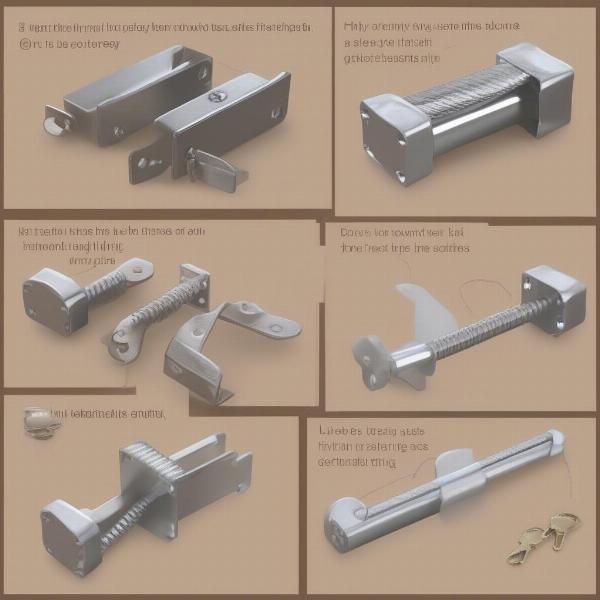Choosing the right dog crate is a significant decision for any pet owner. While factors like size and material are crucial, often overlooked is the importance of secure and reliable dog crate latches. A faulty latch can lead to escapes, potential injuries, and anxiety for both you and your furry friend. This guide delves into the world of dog crate latches, exploring different types, common problems, maintenance tips, and how to choose the best one for your dog’s needs.
Types of Dog Crate Latches and Their Pros and Cons
Various types of dog crate latches cater to different crate designs and dog breeds. Understanding their strengths and weaknesses can help you make an informed decision.
Slide Bolt Latches
These are the most common type, featuring a simple sliding bolt mechanism. They are generally easy to use and affordable. However, for particularly strong or determined dogs, slide bolt latches might not offer sufficient security. Some clever canines can learn to manipulate them.
Double-Locking Latches
Double-locking latches provide an extra layer of security by requiring two separate actions to open. This makes them more escape-proof, especially for Houdini-like dogs. They are generally more robust and durable than single slide bolts.
Gravity Latches
These latches use gravity to secure the crate door. While convenient for quick closure, they might not be the most secure option for strong or anxious dogs who could potentially force the door open.
Wire Clip Latches
Often found on wire crates, these latches use a spring-loaded clip to secure the door. They are generally easy to use but can be less durable over time and susceptible to damage.
 Types of Dog Crate Latches
Types of Dog Crate Latches
Choosing the right latch depends on your dog’s breed, temperament, and the crate’s overall construction. For strong or anxious dogs, a double-locking mechanism is highly recommended.
Common Problems with Dog Crate Latches
Even the sturdiest latches can encounter issues. Recognizing these common problems can help you address them promptly.
Rust and Corrosion
Exposure to moisture or urine can lead to rust and corrosion, weakening the latch and making it difficult to operate. Regular cleaning and lubrication can prevent this issue.
Bent or Broken Components
Rough handling or excessive force can bend or break latch components. Inspect the latch regularly for any signs of damage and replace it if necessary.
Sticking or Jamming
Dust, dirt, or debris can cause latches to stick or jam. Regular cleaning and lubrication can keep them functioning smoothly.
Maintaining Your Dog Crate Latches
Proper maintenance is essential for ensuring the longevity and effectiveness of your dog crate latches.
Regular Cleaning
Clean the latches with a damp cloth and mild detergent to remove dirt and debris.
Lubrication
Apply a pet-safe lubricant to the moving parts of the latch to prevent sticking and rust.
Inspection
Regularly inspect the latches for signs of wear and tear, such as rust, bending, or broken components.
Choosing the Right Latch for Your Dog
When selecting a dog crate latch, consider the following factors:
- Dog’s Breed and Temperament: Stronger or more anxious dogs require more secure latches.
- Crate Material and Design: Ensure the latch is compatible with the crate’s design.
- Durability and Security: Choose a latch made of sturdy materials that can withstand wear and tear.
- Ease of Use: The latch should be easy for you to operate but difficult for your dog to manipulate.
“The safety and security of your dog should be paramount when choosing a crate and its latch,” says Dr. Emily Carter, a certified veterinary behaviorist. “A well-maintained, secure latch not only prevents escapes but also provides your dog with a sense of security within their crate.”
Conclusion
Dog crate latches are a small but vital component of your dog’s crate. By understanding the different types, common problems, and maintenance tips, you can ensure your dog’s safety and security while crated. Choosing the right latch and maintaining it properly will contribute to a positive crate training experience for both you and your furry companion.
FAQ
- How often should I clean my dog’s crate latch? Clean the latch weekly or as needed, especially if it becomes soiled.
- What type of lubricant should I use on my dog crate latch? Use a pet-safe, non-toxic lubricant.
- My dog keeps escaping from his crate. What should I do? Check the latch for damage and consider upgrading to a more secure option, like a double-locking latch.
- Can I replace a broken latch myself? Yes, most latches can be easily replaced with basic tools.
- What is the most secure type of dog crate latch? Double-locking latches are generally considered the most secure option.
- How can I prevent my dog from breaking his crate latch? Ensure the latch is appropriate for your dog’s size and strength and provide plenty of mental and physical exercise to prevent boredom-related destructive behaviors.
- Where can I buy replacement dog crate latches? Pet supply stores, online retailers, and the crate manufacturer often sell replacement latches.
ILM Dog is your trusted resource for all things dog-related. From breed selection to health and training, we provide expert advice to help you give your furry friend the best possible care. We offer a wide range of services to support you throughout your dog’s life, including guidance on nutrition, grooming, and product selection. Contact us at [email protected] or +44 20-3965-8624 to learn more. ILM Dog is here to help you and your canine companion thrive.